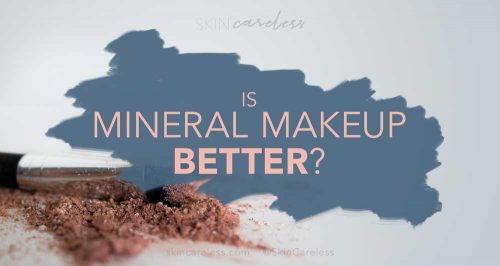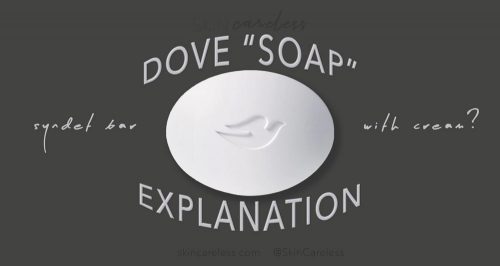You’d be forgiven for thinking I must be lying if I told you that only a little while ago, everybody was clambering to put laxatives on their face.
But, believe it or not, over the past 10 years tons of influential people have touted the “incredible” results they get from using Milk of Magnesia as a magic makeup primer. I even listened to them and did it myself.
But that was a while ago, and since then I’ve become older and wiser, and I can’t help but wonder – how does it work? And, more importantly, is Milk of Magnesia OK to use straight on your skin?
I’m gonna delve deep into this beauty legend, including where it began, what’s true and what’s at risk when you use Milk of Magnesia on your face.
What is Milk of Magnesia?
First up: It’s not milk and it’s not even a drink per se, so that’s a confusing name.
Milk of Magnesia is the branded name for a magnesium hydroxide solution – that’s a compound made from magnesium and water. Magnesium is the 4th most common atom in our bodies, and plays an important role in all sorts of functions that keep us alive.
Milk of Magnesia is a product designed for medical/health support to be taken by drinking a small amount. It’s a white, milky liquid (I presume that’s where it got its name) that has a very alkaline pH. It sometimes has added menthol or other minty flavouring to make it more palatable (we’ll get to why in a minute).
The compound is noted to be a corrosive and irritant.
What is Milk of Magnesia for?
A milky-looking single-ingredient medicine named after a drink is a bit of a strange sight… so who developed it in the first place and why?
Well, it’s not a new invention. The specific 8% solution of magesium hydroxide known as ‘Milk of Magnesia’ was first developed, patented and released to the public for antacid use by Phillips way back in the 1870s.
Still ubiquitous even today, the most common use for Milk of Magnesia is as an antacid (treatment for heartburn) and laxative (treatment for constipation). Its affordability, effectiveness, multi-uses and safety makes it a bathroom staple worldwide.
For some people, uncomfortable heartburn and indigestion is caused by an irritated stomach or esophageal lining that’s sensitive to the strong food-digesting acids in our stomachs. The alkaline Milk of Magnesia counterbalances those natural acids, helping people feel more comfortable. It’s a saline (salt) hyperosmotic (water-absorbing) laxative, meaning when it travels through the stomach to the bowels, it draws water from the lining of the bowels and the blood vessels that serve it into the stool, increasing liquid content and thus remedying any… blockages.
(It’s also used as the main ingredient in some types of deodorants. And most interestingly, it’s an effective and common fire retardant used to produce fire extinguishers.)
But all that aside, what we’re really interested in is why people started putting it on their face.
The popularisation of Milk of Magnesia as a skin care product
It was actually the Phillips company themselves that believed that Milk of Magnesia had more uses than first met the eye. After the success of Milk of Magnesia, they went on to patent two more products – a skin cleansing cream and moisturiser – also harnessing the power magnesium hydroxide. The idea was that excess fatty acids (an essential part of the skin barrier) were to blame for acne, dullness and general lacklustre skin. Though the products never really took off, the idea clearly stuck around in the shadows until the new century.
Milk of Magnesia re-entered the beauty realm in the early days of YouTube. The late 2000s and early 2010s was a time where DIY skin hacks were a new thing, and people were beginning to share all sorts of ideas online – for better or worse – with a novel balance of relatability and authority.
I remember Milk of Magnesia going viral for being able to mattify your skin like nothing else. I personally found out about it from Goss Makeup Artist (a content creator who I still enjoy to this day), who demonstrated its super mattifying abilities that made pores disappear and makeup stay put for hours.
He and others who showed the technique all used a similar method for the results: first, they would shake their super-affordable bottle of the laxative and apply it to a cotton pad. This was then dabbed and spread all over the face and left to dry. You could quickly see it turn white and chalky on their skin, immediately bringing up doubts that this was a legitimate option for a makeup base. Then, on top of that, foundation went right on and surprisingly completely covered it up. More so, not only did it look great initially, but it stayed looking great for hours on people who had skin that usually ate foundation for breakfast.
In a time where matte skin was all the rage and teens were dominating the online space (the statistically oiliest age group and those with the least disposable income for new beauty products), this trick took off like a rocket and quickly became the hottest trend.
I’ve actually tried Milk of Magnesia as a primer and oil-control technique personally. As someone with incredibly oily skin, I was desperate to use anything to help me keep my foundation on for more than an hour at a time. And that it did.
How does Milk of Magnesia counteract oil production and work as a primer? Does it work?
Magnesium hydroxide is a salt. If you’ve ever seen some on the skin, you’ll know it dries to a chalky, opaque white finish. Think kind of like a bad quality face paint. That white residue is actually the mineral salts left behind once the liquid evaporates away. And similarly to the mechanism of action when you take it orally for constipation, Milk of Magnesia on the skin will absorb any water and other liquids it can find. That includes sweat from your face and water in your makeup products. The results is a super smooth, matte looking base.
Milk of Magnesia literally obliterates visible oiliness by dehydrating the skin, thus diverting any natural oils into those parched lower layers to do damage control, where they won’t be seen on the surface. So as far as I can tell, it doesn’t actually make your skin produce less oil, but rather just sucks up water and gives the illusion of a more matte base.
All together, this makes it a pretty compelling and effective foundation primer for some skin types. Is that all it can do?
Some people have claimed that a DIY face mask using Milk of Magnesia can do things like erase wrinkles or treat acne. Unfortunately, this is a total fabrication. There is no study or even reason given as to how this would work. The mattifying effect may give the appearance of a slightly blurred, more smooth skin texture, making wrinkles less noticeable, but it’s nothing a real primer can’t do and certainly not anything breathtaking.
While I also get the idea of an oil-control product being used as an anti-acne treatment (because a lot of people associate oil with breakouts) there’s no evidence to show that this is effective in any way. Milk of Magnesia doesn’t make you less oily deep down, it just makes it harder to see on a purely superficial level. So consider that myth busted.
But you can’t argue with the results when it comes to creating an unparalleled matte base. However, there are some serious drawbacks to using this product for a use it’s not designed for – and they make it unsafe as a long term primer option.
Why it’s not safe to use Milk of Magnesia on your skin – let’s discuss the risks.
I’m by no means a clean beauty freak or a fearmonger. I have no issue with things being used in both personal cosmetics and industrial uses and understand that ‘toxic in large amounts’ does not mean ‘unsafe for your skin’. But nonetheless, there are four key reasons why using Milk of Magnesia as a face mask or primer is a really bad idea:
- pH
- drying effect
- fragrance
- additional ingredients such as bleach
High pH
First up, let’s talk about the biggest problem: pH. Milk of Magnesia has a pH of somewhere around 10. That’s up there with soap and baking soda, and you know how I feel about those in skin care (not good). Our skin sits at a cosy mildly acidic pH (around 5, if you’re curious). Far more alkaline things (and super acidic things, for that matter) mess with your skin barrier and increase the risk of acne and other infections taking hold. The natural flora of our skin are designed to live in harmony at their current acidity. When this is tampered with, all sorts of things go awry. Most of all, you can actually start to cause real issues with dermatitis and burns. I’ve already written a whole post dedicated to explaining why our skin needs to stay at the exact pH it’s meant to be.
Drying effect
As I mentioned, Milk of Magnesia is made of a liquid suspension of what is essentially salt. Like any other salt, that means it’s going to be very drying. You use salts to dry up slugs and de-ice roads. They don’t have any place in a routine that’s focused on hydration like yours should be.
Flavouring/fragrace
Next most concerning is the intention for Milk of Magnesia to be taken orally. To make the otherwise gross liquid palatable, many brands add mint or menthol flavouring and scent to make it go down easier. Fragrance is actually a really undesirable ingredient in skin care as it can trigger inflammation which leads to free radical damage. And worse yet if it’s made with essential oils, which are a whole problem in and of themselves. And if it’s menthol in the formula, that will increase blood flow to the skin and really aggravate any acne or other skin conditions you may have, exacerbating swelling and redness.
Other harmful ingredients
Some formulas of Milk of Magnesia include sodium hypochlorite. This is another salt and also a bleaching agent, probably used here as some sort of preservative. Unfortunately, it’s quite a volatile substance and definitely not suitable for your skin. Most problematic is its reactive potential, meaning when exposed to water it creates free radicals that trigger the chain reaction of oxidative damage (much like smoking and UV exposure do). This is a fancy way of saying they damage and kill deep-down skin cells (such as fibroblasts and keratinocytes), meaning faster and potentially irreversible visible ageing and serious long-term damage.
But don’t just take my word for it, some people are coming forward now, years after this trend had its heyday, and talking about their experience using Milk of Magnesia long term. Check out this video from Youkeyy who used Milk of Magnesia as a primer for 5 years:
So, is Milk of Magnesia OK for your skin?
In a nutshell, no.
All of the above is obviously a worst-case scenario. You probably aren’t going to break out in hives or instantly age 20 years if you try it out once, but using Milk of Magnesia on your skin habitually carries a lot of risks and negatives, making it something you should just stay away from. Premature ageing, severe irritation and and increasing your risk of infections are all totally possible side effects from using Milk of Magnesia as a primer.
Opt for the safe route instead and find a primer designed for the skin. Oily skin is one of the number 1 concerns around the world, and companies have responded by making some truly awesome mattifying foundation primers that will replicate the look of Milk of Magnesia without any of the nasty side effects.
By far my favourite mattifying primer I’ve used so far is the Benefit Porefessional Matte Rescue Gel Invisible Finish
This beefed-up version of the cult-favourite Porefessional primer is a clear gel (unlike the original skin-tone formula). It feels less siliconey and slippery than the original, and more like a tacky gel base instead. It’s super matte and grips really well onto my foundation. I have to be careful when I use it to moisturise well beforehand or else it just ends up too dry. It definitely gives me the look Milk of Magnesia did with none of the messing about with chalky liquids or risking my skin’s health!
Much like I’ve said before in my posts tackling beauty myths and controversial products – like Rodan & Fields skin care, essential oils and african black soap – if Milk of Magnesia is a staple in your routine that works for you, that’s great! You’re lucky, and I hope it stays that way forever (though it may not). Doing the “wrong” things once in a blue moon probably won’t hurt anybody, but I’d like to encourage you to consider all the scientific facts above your own experience when it comes to recommending for others to do the same.
When it comes to skin everything is so personal, which makes it all the more important to assess risks objectively rather than relying on anecdotal evidence before trying something out for the first time. If you’re considering trying out Milk of Magnesia as a primer, this skin care expert recommends you give it a miss and save it for the medicine cupboard, and use a regular primer instead.






[…] means NO BAKING SODA and NO MILK OF MAGNESIA. I’m looking at you, Instagram “gurus” and Pinterest DIYs. Baking soda is often […]
What a load of rubbish!!!! I’ve been using MOM for 0very 7 years on my skin EVERY SINGLE DAY. In fact, I use it as a mask daily and also use it as a primer and my skin is as smooth as a baby’s bum. I do not have a single wrinkle at 34 and my I’ve never had a single breakout ever since i started using thing. This article is clearly paid for by a prodict company that’s losing money due to the decline in sales of products that have now been replaced by Milk of Magnesia!
This post certainly wasn’t sponsored, and I’m disappointed that you feel so upset by my research. If your skin holds up fine to milk of magnesia, go ahead and use it! I’m glad for you, it really does make a wonderful mattifying primer. Some people, like me, have more sensitive and weak skin and might not know that products like these can throw it out of balance. Or perhaps they just want to move on to a more scientifically-minded routine, which involves critically analysing cost vs. benefits of certain habits and products they’re used to, and accepting that they might not be so safe after all.